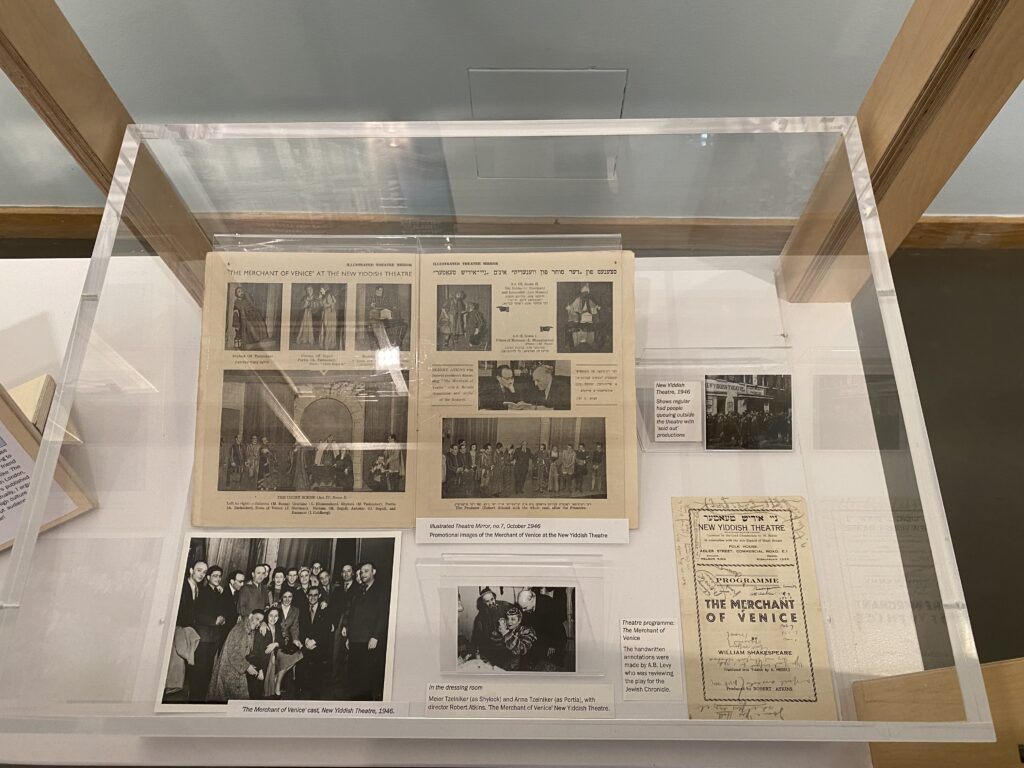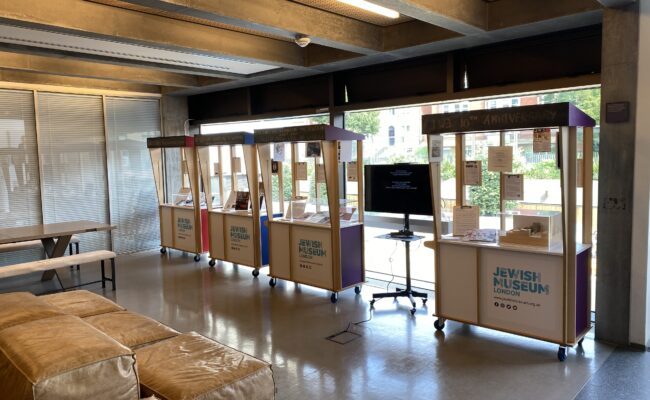A conversation between Jewish Museum London & Katie Power, PhD student, Uni of Southampton/ Parkes Institute

Museum: tell us about yourself and your studies into Yiddish theatre.
Power: I’m Katie and I’m a doctoral researcher at the University of Southampton where I do my research within the Parks Institute for the study of Jewish, non-Jewish relations. In 2010 I did my BA in Jewish history and culture, followed by their MA and that’s when I started learning Yiddish. That developed into the PhD project I’m doing now, which looks at the Yiddish theatre in London during, and after the second world war.
My original research was looking at the two main theatre companies at the time, but it evolved to looking at just the New Yiddish Theatre Company; their mission, their repertoire, the people involved, and really what their cultural aim was because they were very much driven by this cultural mission that you didn’t see in their rivals at the Grand Palais. That said, one of my conclusions is that although there’s these two theatre companies, they actually were very much one entity.
The people between them swapped, there were squabbles and people would leave and go to the other company, they shared their repertoire, they were sharing their performances. The difference really came down to funding. There was an implication that the New Yiddish Theatre had money, they paid their staff, they performed without worrying about the revenue. Whereas the Grand Palais, they didn’t have that luxury, so they couldn’t pay their performers and they relied on box office takings where you just got a percentage that was negotiated. But together they defined London, Yiddish theatre in the post-war period.
The New Yiddish theatre’s mission was what made them very unique because from day one, they set out this mission, their ‘10 commandments of coming to the New Yiddish Theatre’; behave yourself, represent us well, bring your friend who doesn’t speak Yiddish. There were constant calls in publications like ‘The Mirror’ to the youth; this idea that, if you are a good Jewish citizen in London, you’re going to keep this part of Jewish cultural identity alive. It’s published everywhere. They just kept singing and talking about it. But actually, I argue that it wasn’t realistic to maintain that whole debate of art, high culture and low culture. Instead, it’s actually about business, it’s about audiences, it’s about people. And there’s nothing wrong with being popular!
Selecting an object
Museum: How do the objects that you’ve chosen demonstrate the New Yiddish Theatre’s mission?
Power: So I’ll start with the ‘Theatre Mirror’. It was incredibly rare for a London Yiddish theatre to have its own publication. They were using this to show off everything, to both non-Jewish and non-Yiddish audiences. This was a tool to make sure that people knew what they were doing and to make sure that their activities were documented in a way that showed off that they were important.
I chose this particular spread because people often don’t think about this as a source. And the Merchant of Venice itself, is a particularly important staging for them, because it entwined this idea of Jewish identity, and the interpretation of Shylock. But it also brought in the English side of things. It was a way of saying, look, we can do Shakespeare, we can do the great English bard, and we can do that in Yiddish and still be amazing. They’ve put the effort in to show off what they can afford to do, and that they are serious about it.
Best of all Robert Atkins directs; the non-Yiddish speaking, non-Jewish, very much the go-to acclaimed director of Shakespeare. And to get him on board would have been an immensely proud achievement for the New Yiddish Theatre.
The English vs Yiddish descriptions are interesting too; you just need the names if you’re the English reader, but if you want the detail, you need to learn Yiddish.
The photo of the people outside the theatre shows it wasn’t just a Jewish or Yiddish speaking audience. The merchant of Venice had this appeal and people were attracted by the ‘exotic’ nature of Shakespeare in Yiddish. Even though it had been performed in London, in Yiddish before, it was the first time for this generation.
For the cast photo, this group saw themselves as the beacons of Yiddish Jewish identity at this time. Seeing them out of that, not worrying about that side of things is quite humbling. For a company who pride themselves in being top quality, interestingly there were cast members who originally didn’t speak Yiddish. The theatre took on non-Yiddish speaking refugees and coached them.
At this point Meier Tzelniker was at the peak of his career. He was seen as the man to go to for the big roles. And Meier and Anna were the first father daughter pair to play Shylock and Portia. I love this photo because I think Meier looks really happy and really enthusiastic about it. I can imagine him coming up behind her saying, ‘go get them’ or ‘this is going to be great’. And I always think it’s a photo that again shows the human side behind the performance. And then Robert Atkins is behind Anna and you can see that he was really proud of what he did. He was proud of them.
I guess it’s part of the story for me that all these objects show a story of one performance of one production of one company. But the last object, the programme, for me is fascinating because it has A.B. Levy notes, a reviewer for the Jewish Chronicle. It’s actually been really useful to my research; his notes tell me far more about the performance than a normal programme or review because it’s actually what’s happening. And I chose it because I wanted people to see the names of those involved. I want people to see how they were styling it, how they were presenting these performances, that they were using Yiddish and English, trying to make it accessible to everyone.
The scribbles show that this was something in the moment. It was something that someone used, sitting there writing away. Those scribbles are quite passionate, quite intense. There’s a lot going on there.
—————————————————————————–
For more information visit: www.katie-power.co.uk
